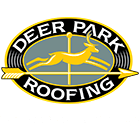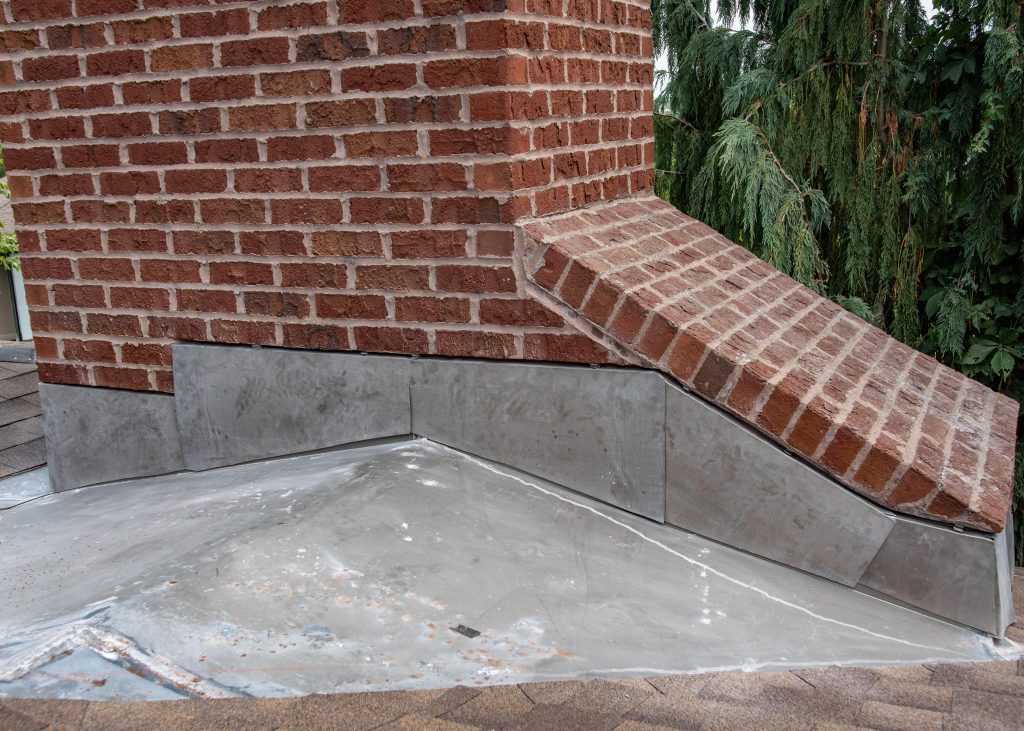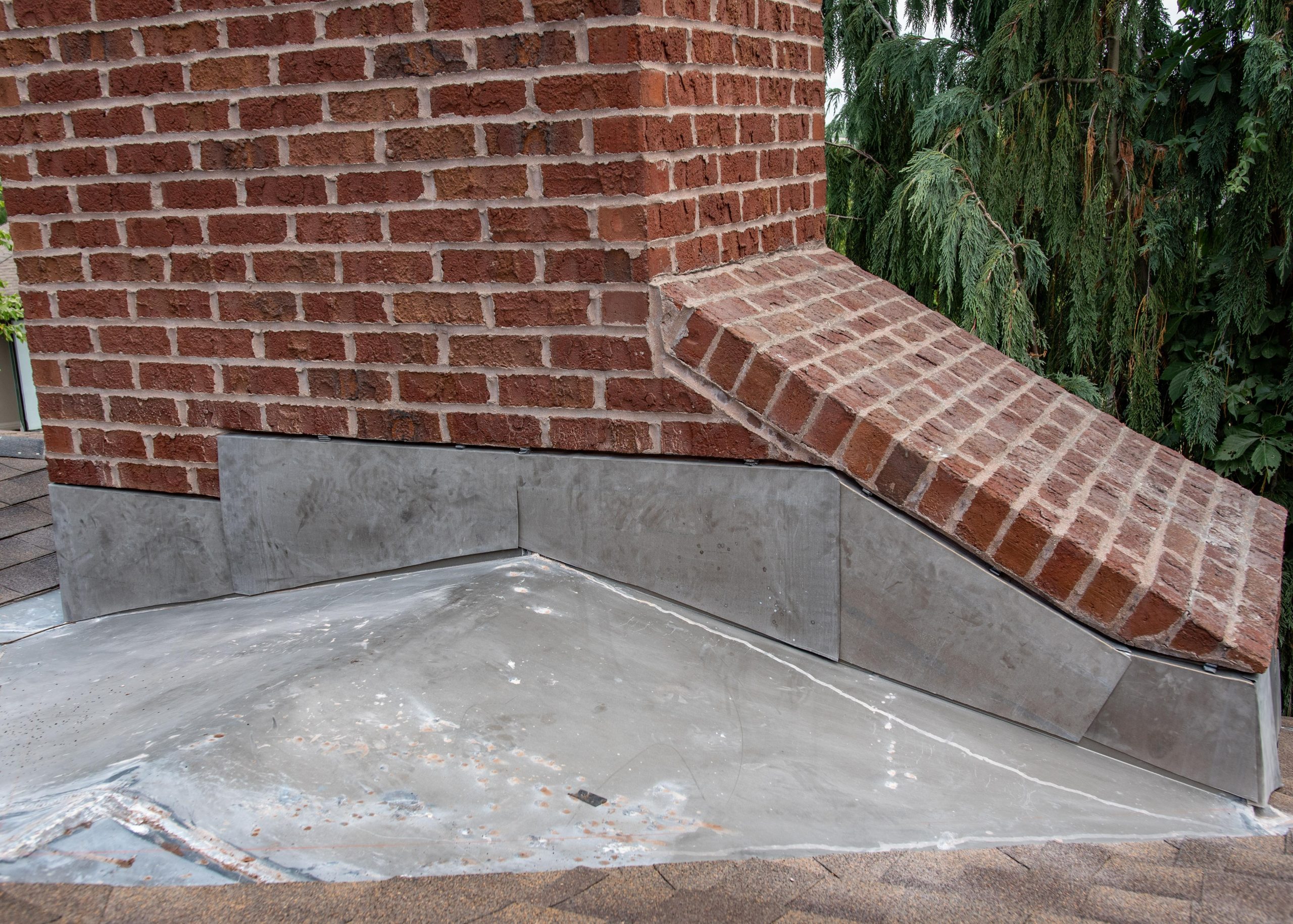
Roof Flashing: different types, how to install them, and when you should replace them
If we look at a pie chart of our monthly service requests in Louisville Ky, leaks at roof flashings are the biggest piece of the pie. A poorly installed flashing repair compromises the integrity of the roof. At Deer Park Roofing, we take extra care in replacing flashings by going above and beyond in every repair. If you are replacing your roof, be sure to replace all flashings as well. Doing this saves money in the long run, which we will talk about later in the article. Below, we’ll look at different types of roof flashing and describe our installation procedures.
What is Roof Flashing?
A roof system requires flashings to weatherproof any area where a penetration occurs. This includes rakes and eaves, pipe vents, walls, skylights, chimneys, and valleys. Flashings are the most important component of a roof. If the flashing is not installed with great attention to detail, leaks will occur. We make flashings from 26-gauge or thicker sheet metal, and we custom fabricate each piece in our warehouse or on the jobsite. Each piece of flashing should always overlap to clearly direct water toward gutters. Some types of roof flashing are counter flashing, chimney flashing, step flashing, headwall flashing (also called apron flashing), valley flashing, and gutter apron flashing.
Counter and Chimney Flashing
We install counter flashing on brick/masonry walls above the roof surface to cover the top of other flashing, such as step flashing. This directs the flow of water away to prevent leaks. Flashings should always overlap so water does not run behind the top of the flashing and get into the building.
Chimney flashing is mainly comprised of counter flashing. Without chimney flashing, rainwater would easily leak into the house along the base of the chimney.
Installing chimney flashing starts with installing counter flashing. We first grind the actual mortar joints of the chimney down approximately 1 inch using a circular saw. This makes room for a custom fabricated piece of flashing.
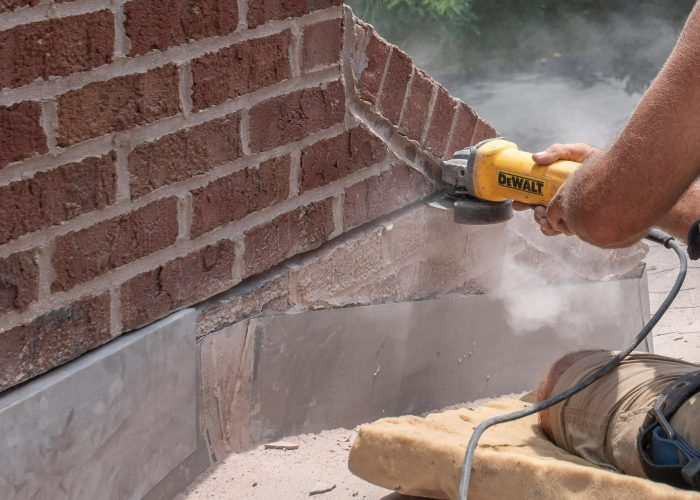
We use 26-gauge steel for our chimney flashing, which is far more durable than lighter aluminum flashings. Every piece of counter flashing is hand cut on site to ensure a perfect fit.
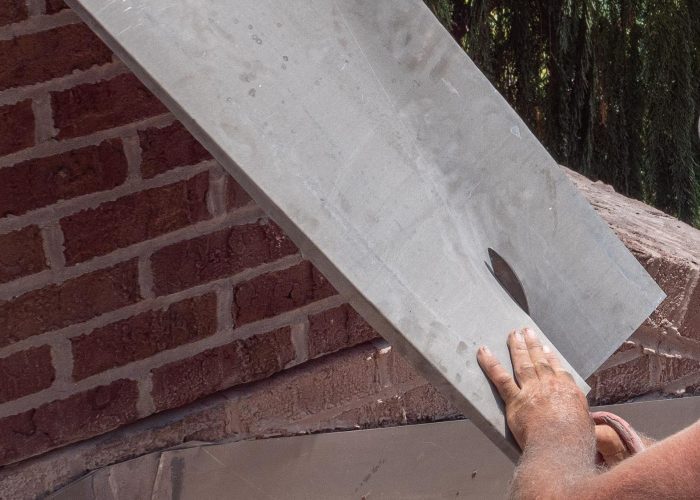
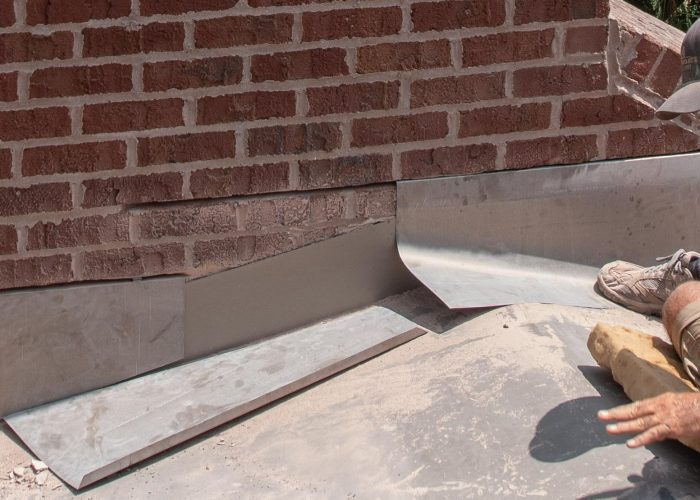
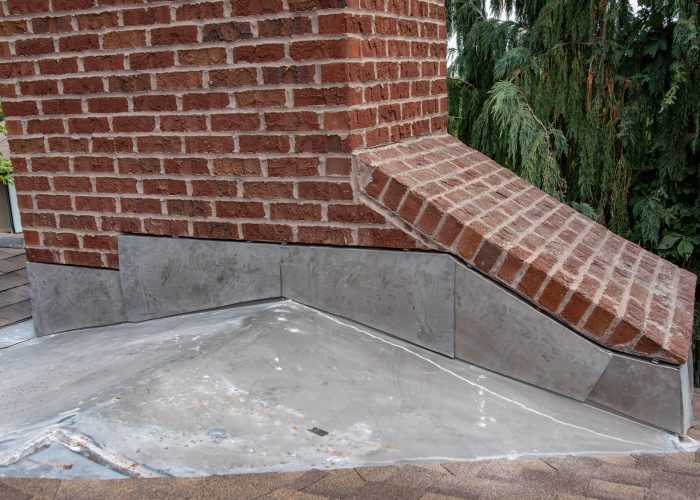
Next, we fuse the overlapping counter flashings together with solder. Then we paint them with an industrial acrylic coating to prevent rust and corrosion.
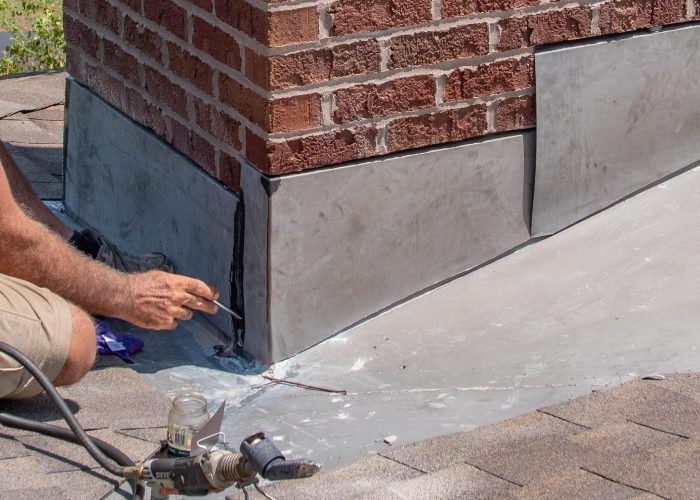
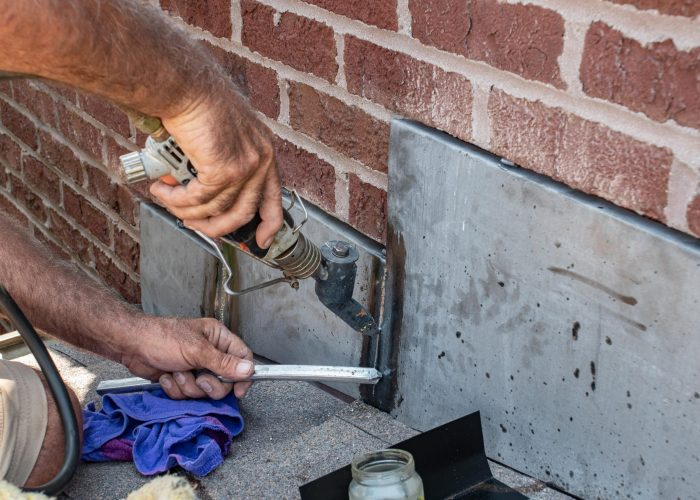
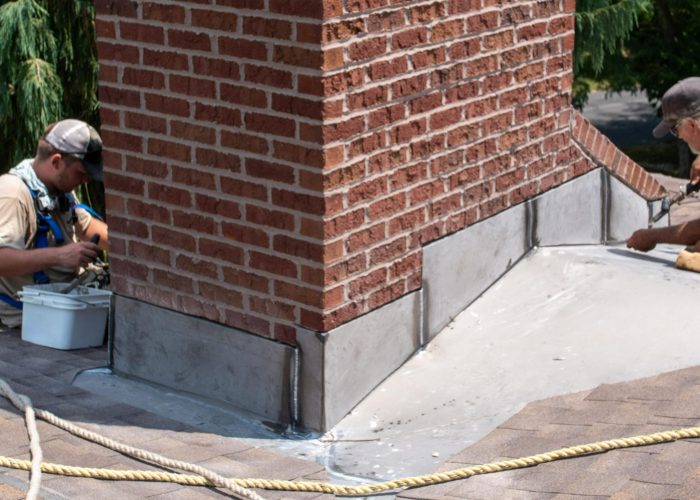
Deer Park Roofing does not use caulk when installing flashings because it doesn’t last as long as solder and mortar. The average life span of flashing is 40 years, and caulk will typically erode in 5 years. Solder and mortar do not erode and last for 40 years. When choosing a contractor to do flashing repairs, ask them what sealant materials they use, as this directly affects its life expectancy. Click here to read our article on the difference between solder versus caulk.
After placing and soldering the counter flashing, we tuck point, i.e., fill in, gaps in the masonry joints with mortar. Click here to view our page on masonry and learn more about this process.

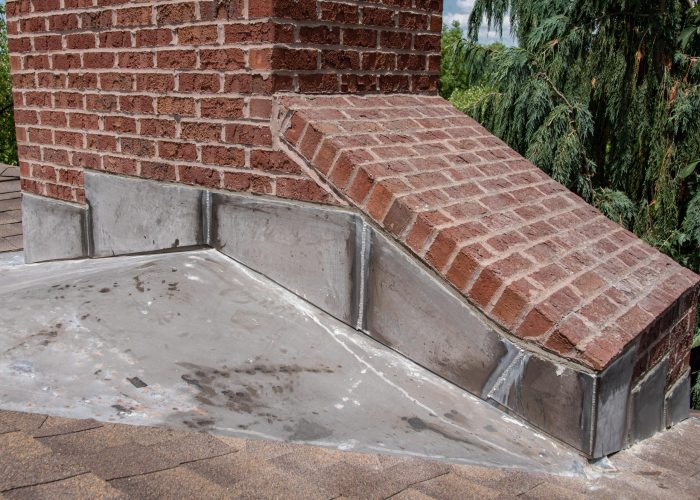
Step Flashing
We install step flashing against walls and other penetrations on a roof to prevent leaks. This flashing sheds water to the course below it so it does not need solder or sealant. For this reason, we fabricate step flashing from a pre-painted metal to prevent corrosion. Step flashings should extend at least 2 inches past the course above it to help water flow towards the gutters.
Counter and step flashing are often used together. Step flashing can be placed behind siding, while counter flashing cannot. Step flashing is used with any type of siding as long as you cover the top of it with another piece of cladding.
Headwall or Apron Flashing
We install headwall flashing, also called apron flashing, where vertical walls intersect the roof. It prevents leaks by guiding water running down the wall onto the roof system. We place headwall flashing behind siding. If your house has a brick headwall, we install counter flashing to overlap the top of the headwall flashing.
Deer Park Roofing prefabricates all headwall flashings from 26-gauge steel in our shop to ensure consistency and performance. We create 3 bends to add strength, then round corners to promote proper drainage. Again, we solder the seams for added durability. Then, we paint the metal flashing with an industrial coating.
Valley Flashing
We install valley flashing at angle changes in a roof system. There are many approved methods for valley installation. We find that the open no-cut valley method works the best. This method gets its name from the NRCA Roofing Manual: Steep-slope Roof Systems.
The first step in this method is to install an ice and water shield up the center of the valley. This is a self-adhering membrane that that adds an extra layer of protection to the roof. On top of this, we install the metal valley liner. Next, we line shingles along the valley to prevent water from draining into the shingle courses. A shingle course is a row of shingles that directs water to the row beneath it. Every component of the roof, especially shingles, needs to point down to direct water to the gutters. Below are examples of valley flashings.
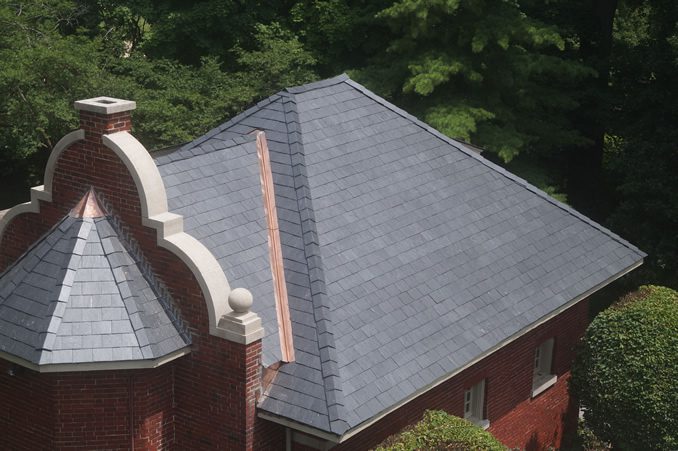
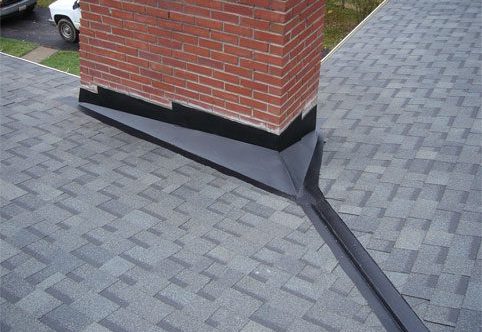
Gutter Apron Flashing
We install gutter apron flashing along the gutter line, which is where the roof and gutter meet. At this intersection there is a gap that is formed from the fascia trim board and roof sheathing. This flashing has a drip edge, which is a lip on the metal that keeps water from draining onto other building components. This bend in the metal also strengthens it, making it less flimsy. When installed correctly, this type of flashing overlaps to stop voids from forming. It directs water into the gutters, protects the roof from weather, and prevents insects and animals from entering the attic.
First, we secure the gutter apron flashing to the roof sheathing. Then we install an ice and water shield on top of this. Next, a starter course of shingles is placed on top of the ice and water shield. After this, the shingle courses can be installed.
When should I repair my roof flashing?
Flashing repairs are expensive, so we recommend replacing all flashings when getting a new roof. Life expectancy of roof flashing is 40 years when installed properly. Repairing flashing costs 4-5x more than it does to replace it during a new roof installation. There is an added cost due to time and labor spent removing that section of the roof. When replacing a new roof, the area is already being removed.
Deer Park Roofing believes in creating things that last. We do our job well so customers don’t have more problems down the road. This is why we replace all flashings on new roofs.
If flashings leak before replacing the roof is necessary, we can repair them. Some of the roofing materials next to the flashings will need to be replaced during the repair.
In some cases, roof flashings are not leaking but still need replacing if they begin to rust or come loose. Again, Deer Park Roofing uses an industrial acrylic coating to ensure roof flashings are secure and do not rust.
If your flashing is leaking in Louisville Kentucky, call Deer Park Roofing Inc. right away to get it taken care of the correct way.
What should I do if my chimney is leaking?
There are several causes of chimney leaks, either roof or masonry related. Best practice is to check chimney flashing first, where the metal or seal at the masonry may have broken. The masonry, i.e., brick, block, or stone, itself can often absorb water, especially if the chimney is made from stone. If the masonry becomes saturated, water will drip through and cause leaks. Defects in the mortar joints can also cause chimney leaks. Lastly, the chimney crown may be cracked and need repairing.
If you are worried about a problem with your roof flashing, request a free estimate from a professional roofing contractor that specializes in metal fabrication and installation like Pittman Waller in Macon, GA.
This article was authored by Deer Park Roofing, LLC President Nick Sabino.
If you have any other questions about roof flashing or any other part of your roof, contact the experts at Deer Park Roofing in Louisville, KY
